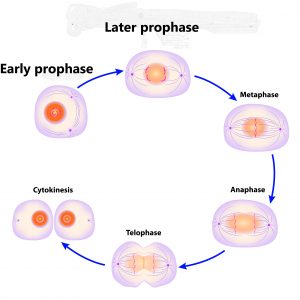Cell Division and MCQs for NEET, GPAT, CSIR NET JRF Exam
Cell division is a process by which the cell reproduce themselves. Most of the body cells undergo cell division. There are two types of of cell division- somatic cell division and reproductive cell division. In reproductive cell division, it produces gametes, cells needed for generating sexually reproducing organisms. This process includes two step division called as meiosis; here the number of chromosomes in nucleus in child cell is reduced to half of parent cell.
In somatic cell division, the cell undergoes nuclear division known as mitosis; and also the cytoplasmic division called as cytokinesis. This division produces two identical cells having same number and kind of chromosomes as the parent cell. Somatic division replaces dead or injured cells and also adds new cells during cell growth.
SOMATIC CELL DIVISION
A cell division is a sequence of events by which a somatic cell duplicates its contents and results in two cells. When a cell reproduces, it must replicate( means duplicate) all its chromosomes to pass their genes to the next generation cells. A cell cycle consist of two major phases :- the interphase during which the cell grows and does not divide; and the mitosis phase during which the cell divides.
Interphase
During this phase, the cell replicates its DNA. It also produces additional organelles and cytoplasmic components. Interphase is a phase during which high metabolic activity occurs; and during this phase, the cell does most of its growing. The interphase consist of 3 parts:
- G1 phase- this is a part between the mitosis and s-phase. This part of interphase occurs for 8-10 hours out of 24 hours. During this phase, the cell is metabolically active. Replication of many organelles and cytoplasmic contents occur during this phase. Also the replication of centrosomes begins. All the non-dividing cells like nerve cell remain in G1 phase for long time and are said to be in G0 phase; and exits from the cell cycle.
- S-phase- this phase is between the G1 phase and G2 phase. It occurs for 8 hours. During S-phase, DNA is replicated; as a result, the 2 identical cells formed during cell division will have same genetic material. Once the cell enters the S-phase, it necessarily undergoes cell division.
- G2 phase- This phase is between the S phase and mitosis. It occurs for 4-6 hours. During this phase, cell growth continues and enzymes and other proteins are synthesized. Also the replication of centrosomes is completed.
Mitotic phase
The mitotic phase of cell cycle consist of the nuclear division(mitosis) and the cytoplasmic division(cytokinesis).
The mitosis- is a continuous process, when one stage merges directly into the next one. It has different phases which are as follows:
- Prophase- during early prophase, the chromatin threads condenses and forms short small chromosomes. Nuclear envelops nucleolus disappear. Each formed chromosome consist of pair of identical strands called the chromatids; centromere is a region that holds the chromatids pair together. Outside of each centromere is a protein complex known as kinetochore. In later prophase, the tubulins of centrosomes start to form mitotic spindle.
- Metaphase– the microtubules of the mitotic spindle aligns the centromeres of the chromatid pairs in the center of mitotic spindle. The midpoint region is called as metaphase plate
- Anaphase- the centromeres split, and move towards the opposite poles of the cell. after separation, the chromatids are known as chromosomes. These chromosomes appear V-shaped during this phase.
- Telophase- It is the final stage of mitosis, where the movement of chromosomes stops. The nuclear envelopes and nucleoli reappear; chromosomes again forms chromatid threads. and the mitotic spindle disappears.
Cytokinesis:- during this phase, cytoplasmic division occurs. contractile ring forms cleavage around the center of coil; hence divides the cytoplasm into two equal and separate parts.

Multiple choice questions(MCQs)
1. How many types of cell division occur in our body?
A. 2 B. 4
C. 3 D. 1
2. In reproductive cell divisions, how many chromosomes do child cell have in comparison of parent cell?
A. equal no. of chromosomes B. half of the parent cell
C. one-third of parent cell D. one-fourth of parent cell
3. What is the function of somatic cell division?
A. same no. of chromosomes replicated b. replace dead cell
c. same kind of chromosomes D. all of the above
4. During which phase of interphase, is the cell metabolically active?
A. G1 phase B. S-phase
C. G2 phase D. all of the above
5. Match the following-
a. prophase 1. Nuclear envelop reappears
b. metaphase 2. Chromosomes appear V-shaped
c. anaphase 3. Centromere align in center of mitotic spindle
d. telophase 4. Tubulins form mitotic spindle
6. What is the shape of chromosome during the Anaphase?
A. t-shaped B. s-shaped
c. A-shaped D. V-shaped
7. During which phase, enzymes and proteins are synthesized?
A. S phase B. prophase
C. G2 phase D. telophase
8. Which of the following statement is true?
A. In reproductive cell division, chromosomes are half of parent cell
B. anaphase is the final stage of cell division
C. cytokinesis is about nuclear division
D. S- phase is highly metabolically active phase
9. During which phase, the centrosomes replication begins?
A. anaphase B. metaphase
C. G2 phase D. none of the above
10. When does non-dividing cells exits from the cell cycle?
A. G1 phase B. G2 phase
C. prophase D. cytokinesis
ANSWERS:-
- 2
- half of the parent cell
- all of the above
- G1 phase
- a – 4 b – 3 c – 2 d – 1
- v-shaped
- G2 phase
- In reproductive cell division, chromosomes are half of parent cell
- none of the above
- G1 phase
Participate in Online FREE GPAT TEST: CLICK HERE
Participate in Online FREE Pharmacist TEST: CLICK HERE
Participate in Online FREE Drug Inspector TEST: CLICK HERE
REFERENCE:- Gerard J. Tortora -Principles of anatomy and physiology; edition twelfth ; page no.-: 93-96.